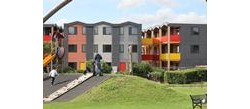Rogers Stirk Harbour & Partners has revealed plans to scale up production of the practice’s “move-on” homes to deliver up to 7,500 a year across the UK.
The practice’s associate partner Andrew Partridge said they had seen a huge interest in the homes – a larger version of the flatpack Y:Cube homes designed for the YMCA in south-west London.
He claimed they could form part of a response to the country’s housing shortage.
“Everywhere has a housing problem, and this can be used anywhere in the UK,” he said.
“We can have different manufacturing points and set them up without much cost. In the south-west there’s an extraordinarily acute shortage of housing for key workers and this can help.
“What has been quite shocking after talking to lots of different people is quite how big the housing problem is, and it’s not the usual candidates. If you look at the Y:Cube, the people there are not your normal homeless, they are studying or have jobs. The problem is extraordinary and frightening.
“We are talking to a London university and they are having issues finding housing for their staff. In Kingston we are in talks about working with the concept.”
Partridge was speaking ahead of the installation of 24 two-bed homes at the Ladywell site in Lewisham.
The practice entered into a partnership with Lewisham council in 2015 to create a deployable residential development using a volumetric construction method on the site of the former Ladywell leisure centre.
The temporary housing development has a maximum procurement budget of £4.3 million and will remain on site for between one and four years.
Lewisham council has contracted RSH&P and Aecom to deliver homes which are bigger than the original Y:Cube apartments in Mitcham. Closer in size to traditional council homes, they will go to people currently living in B&Bs in the borough.
The project is expected to complete in April.
Partridge said that though Mitcham acted as a “proof of concept”, the Lewisham plans had been closely watched by other London boroughs.
“The mayor of Lewisham has done this amazing thing of pioneering the use of these homes and everybody is interested in what they are doing at Ladywell,” he said.
“It’s only deployable because you can take it away and put it somewhere else and is good for places where there is future development that is not ready to begin.”
Original link - Building









